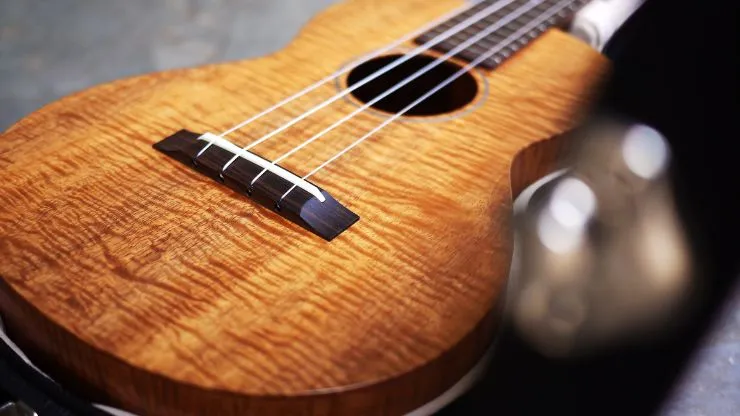What Is Koa?
Acacia koa, informally referred to as koa, is endemic to Hawaii, mainly growing on the islands of Hawaii, Maui, and O’ahu. Over the years, koa has been an essential resource for Hawaiians, who have used the wood for everything from canoes to furniture to ukuleles. Internationally, koa has also become a popular choice for cabinetry, veneers, musical instruments, and gunstocks.
How Is Koa Used in Guitars?
Koa is a very versatile wood with plenty of potential uses in guitar construction. It’s perhaps most popular as a body wood, where it can excel in electric and acoustic instruments. The wood offers easy workability, so it can be easily bent for use on acoustic guitar sides, while it makes an excellent choice for guitar backs. And despite its relative density, it serves well as a top wood, offering a tight and balanced tone with good note clarity.
While it isn’t a common option, koa can also serve as a neck wood. Koa fretboards aren’t unheard of, but better-performing, harder, and cheaper options are available.
How Do Koa Guitars Sound?
Koa offers a well-balanced tone that combines the solid mid-range performance of mahogany with maple’s bright highs. Koa guitars typically start off sounding bright, with stronger treble. Over time and with playing, they tend to mellow out and present more warmth, resonance, and mid-range performance.
Given koa’s initial brightness, you might not get on with this tonewood if you have a hard or bright playing action. But for finger players, those who use gentler strumming or picking, and those who prefer lighter picks, koa can be an excellent choice.
Is Koa Sustainable?
Given that it only grows in Hawaii, Koa does have limited availability. And as it’s seen heavy use over the years, much of Hawaii’s supply of the tree has been depleted. That said, extensive efforts have been taken to safeguard koa and keep it sustainable. Loggers require permits to harvest koa timber, while the Division of Forestry and Wildlife has undertaken significant replanting efforts, planting 170,000 seedlings in over 10,000 acres of land. Additionally, koa wood harvested on the island of Hawaii is taken exclusively from dead and fallen trees. These efforts have kept koa as a species of least concern on the IUCN Red List, and it isn’t listed in the CITES appendices.
Is Koa Durable?
With a Janka hardness rating of 1,170, koa is harder than tonewoods such as Honduran mahogany and alder, though not as tough as rosewood. The wood’s relatively hard and dense nature means that it can put up with plenty of wear and tear over years of use.
Are Koa Guitars Easy to Maintain?
Koa guitars don’t require any special treatment – you can care for it the same way that you would any other guitar:
- Keep at a stable temperature and humidity (around 40 – 60%).
- Clean with a good quality polish.
- Dust with a non-abrasive microfibre cloth.
- Store it in a padded case whenever you aren’t using it.
Is Koa Expensive?
Due to Hawaii’s efforts to preserve the wood, koa is only usually available in limited numbers. This restricted availability, along with the excellent performance and beautiful appearance of the wood, means that guitars makers often reserve koa for premium and limited-run instruments that can be on the pricier side.
What Are the Pros and Cons of Koa?
| Pros | Cons |
|---|---|
| Beautiful, grained appearance | Can be very bright initially |
| Durable | Doesn’t always complement aggressive or bright players who prefer a hard playing action and hard picks |
| Excellent mid-range performance | Expensive |
| Well-balanced tone | |
| Pleasant warmth that matures with use | |
| Easy to work |
Is Koa a Good Guitar Wood?
Koa might not be held in the same regard as luminaries like rosewood, but many guitarists are waking up to the fact that koa is actually a pretty special tonewood. It offers excellent mids and highs, remarkable note clarity, and a warmth that grows over time.
Koa Alternatives
If you’re looking for a more dynamic tonal range with more robust lows and a more scooped mid-range, then rosewood could be for you. Alternatively, ovangkol offers a compromise between the two, with many of rosewood’s qualities but with more koa-like mids and treble.
If you want to go the other way and boost the mids and warmth even more, think about mahogany or sapele. Finally, if you like the idea of koa’s initial brightness and don’t want to lose it over time, consider maple.
Find Your Koa Guitar
If a koa sounds like it could be up your street, it’s time to start searching for your perfect koa guitar! Using our Finder tool, you can use filters like body wood, price, and electronics to narrow your search and make finding your ideal guitar a piece of cake.

